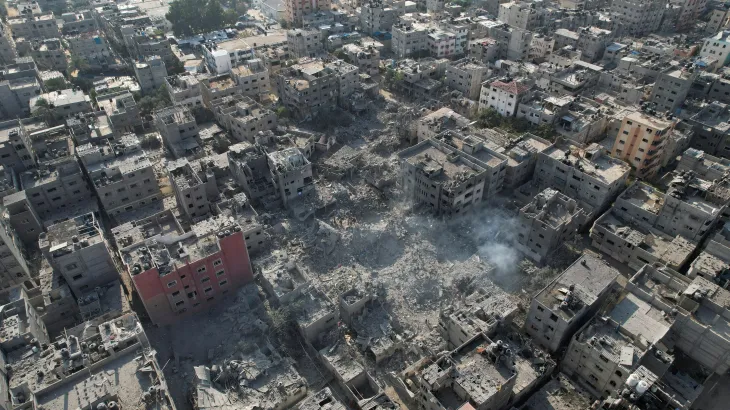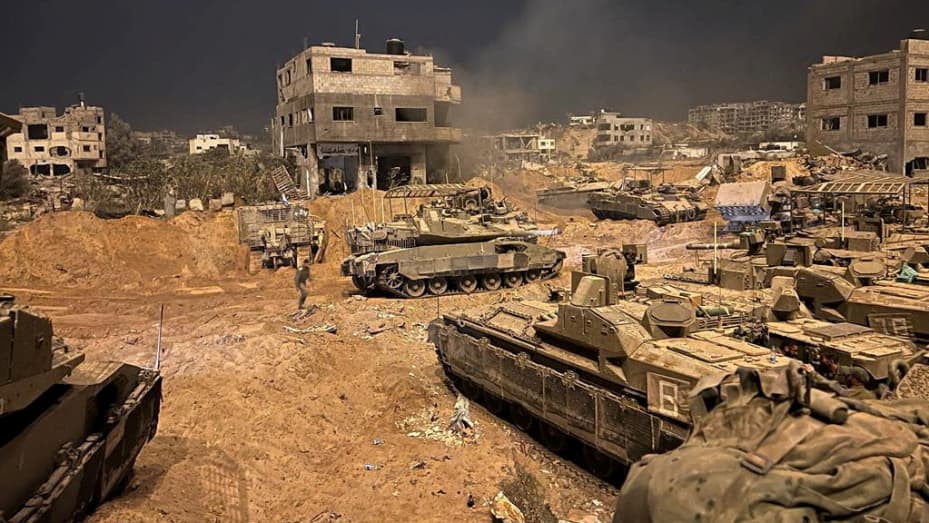
The year 2023 marked a significant and turbulent period for the Middle East, as the longstanding conflict between Israel and Hamas escalated into a full-scale war. Exploring the root causes, major events, and consequences of this conflict offers crucial insights into the complexities and challenges faced by the region.
Table of Contents
Root Causes
The Israel-Hamas conflict has deep historical and territorial roots, stemming from the Israeli occupation of Palestine and Hamas’ resistance against it. The issues surrounding land ownership, settlements, and access to resources have created an atmosphere of mistrust and hostility over the years, fueling continuous violence.
Major Events
The 2023 war witnessed a series of significant events that intensified tensions between Israel and Hamas. The assassination of a prominent Hamas leader, combined with an increasing number of rocket attacks by Hamas towards Israeli territory, triggered a forceful response from the Israeli government. The subsequent Israeli airstrikes targeted key Hamas infrastructure, leading to further casualties and destruction.
Another crucial event during the conflict was the involvement of various international actors who attempted to mediate and negotiate a ceasefire between the two parties. Despite their efforts, achieving a lasting resolution proved challenging due to the deep-rooted animosity and differing perspectives regarding the future of this embattled region.
Humanitarian Crisis
As the conflict escalated, a dire humanitarian crisis unfolded. Civilians found themselves caught in the crossfire, with both Israelis and Palestinians experiencing significant loss of life and widespread displacement. Essential infrastructure, including hospitals, schools, and residential areas, were severely damaged, exacerbating the already fragile plight faced by ordinary people.
International Response
The 2023 Israel-Hamas war captured the attention of the international community, with many nations urging both parties to cease hostilities and engage in dialogue. The United Nations Security Council convened numerous emergency sessions to address the crisis, but a unified stance remained elusive due to geopolitical factors and differing regional alliances.
Consequences and Long-Term Implications
The Israel-Hamas conflict of 2023 had profound consequences on multiple levels and is likely to shape the region’s future significantly. The continuous cycle of violence highlighted the urgent need for a sustainable solution based on mutual recognition, negotiation, and compromise.
The war further strained relationships between Israel and its neighboring countries, exacerbating geopolitical tensions in the region. The potential for the conflict to spill over and ignite larger-scale regional violence remained a real concern, necessitating a renewed focus on promoting diplomacy and stability.
The 2023 Israel-Hamas war highlighted the enduring complexity and deep-rooted nature of the conflict. Amidst the tragedy and devastation, it is crucial for all parties involved to recognize the necessity of dialogue, compromise, and respect for human rights. Only through a concerted effort can a lasting solution that ensures peace, security, and justice prevail in the Middle East.

Unveiling the Background of the 2023 Israel-Hamas War
The history of conflict between Israel and Hamas is a longstanding one, peppered with cycles of violence, negotiations, ceasefires, and broken agreements. As we delve into the background of the 2023 Israel-Hamas war, it is crucial to explore the factors that led to this particular outbreak of violence and the underlying tensions that have plagued the region for decades.
Historical Context
Copied
Historical Context
To understand the 2023 Israel-Hamas war, one must go back to the creation of the State of Israel in 1948, which resulted in the displacement of thousands of Palestinians. This led to the formation of several Palestinian political and military organizations, including Hamas, founded in 1987.
Hamas, an acronym for Harakat al-Muqawama al-Islamiyya (Islamic Resistance Movement), is a Palestinian Islamic organization that emerged as a resistance to what they perceived as the illegitimate Israeli occupation. Fueled by the Israeli-Palestinian conflict, Hamas gained popularity among Palestinians in the Gaza Strip, disconnected politically from the West Bank.
To understand the 2023 Israel-Hamas war, one must go back to the creation of the State of Israel in 1948, which resulted in the displacement of thousands of Palestinians. This led to the formation of several Palestinian political and military organizations, including Hamas, founded in 1987.
Hamas, an acronym for Harakat al-Muqawama al-Islamiyya (Islamic Resistance Movement), is a Palestinian Islamic organization that emerged as a resistance to what they perceived as the illegitimate Israeli occupation. Fueled by the Israeli-Palestinian conflict, Hamas gained popularity among Palestinians in the Gaza Strip, disconnected politically from the West Bank.
To understand the 2023 Israel-Hamas war, one must go back to the creation of the State of Israel in 1948, which resulted in the displacement of thousands of Palestinians. This led to the formation of several Palestinian political and military organizations, including Hamas, founded in 1987.
Hamas, an acronym for Harakat al-Muqawama al-Islamiyya (Islamic Resistance Movement), is a Palestinian Islamic organization that emerged as a resistance to what they perceived as the illegitimate Israeli occupation. Fueled by the Israeli-Palestinian conflict, Hamas gained popularity among Palestinians in the Gaza Strip, disconnected politically from the West Bank.
The Oslo Accords
Copied
The Oslo Accords
In 1993, the Oslo Accords were signed between Israel and the Palestine Liberation Organization (PLO), which sought to establish a framework for peace negotiations. However, these accords failed to address core issues such as borders, settlements, and the right of return for Palestinian refugees.
In 1993, the Oslo Accords were signed between Israel and the Palestine Liberation Organization (PLO), which sought to establish a framework for peace negotiations. However, these accords failed to address core issues such as borders, settlements, and the right of return for Palestinian refugees.
In 1993, the Oslo Accords were signed between Israel and the Palestine Liberation Organization (PLO), which sought to establish a framework for peace negotiations. However, these accords failed to address core issues such as borders, settlements, and the right of return for Palestinian refugees.
Hamas's Ascendancy
Copied
Hamas's Ascendancy
Over time, Hamas grew in influence, challenging the secular Fatah-dominated Palestinian Authority (PA) established under the Oslo Accords. The group won the parliamentary elections held in 2006, stunning the international community and sparking a political divide between Fatah and Hamas.
Over time, Hamas grew in influence, challenging the secular Fatah-dominated Palestinian Authority (PA) established under the Oslo Accords. The group won the parliamentary elections held in 2006, stunning the international community and sparking a political divide between Fatah and Hamas.
Over time, Hamas grew in influence, challenging the secular Fatah-dominated Palestinian Authority (PA) established under the Oslo Accords. The group won the parliamentary elections held in 2006, stunning the international community and sparking a political divide between Fatah and Hamas.
The Gaza Strip
Copied
The Gaza Strip
Following their electoral victory, tensions between Hamas and Fatah erupted into a brief, yet fierce, civil war in 2007, resulting in Hamas taking control of the Gaza Strip while the PA maintained control over the West Bank. From that point on, Gaza effectively became an isolated entity, under an Israeli blockade and severed from the West Bank.
Following their electoral victory, tensions between Hamas and Fatah erupted into a brief, yet fierce, civil war in 2007, resulting in Hamas taking control of the Gaza Strip while the PA maintained control over the West Bank. From that point on, Gaza effectively became an isolated entity, under an Israeli blockade and severed from the West Bank.
Following their electoral victory, tensions between Hamas and Fatah erupted into a brief, yet fierce, civil war in 2007, resulting in Hamas taking control of the Gaza Strip while the PA maintained control over the West Bank. From that point on, Gaza effectively became an isolated entity, under an Israeli blockade and severed from the West Bank.
Cycle of Violence
Copied
Cycle of Violence
Since Hamas assumed control in Gaza, there have been several major escalations between the group and Israel. Periodic rocket attacks from Gaza into southern Israel, coupled with Israeli airstrikes and ground incursions, have created a vicious cycle of retaliation and counter-retaliation. Notable conflicts include the 2008-2009 Gaza War, 2012 Gaza-Israel Conflict, and the most recent escalation in the form of the 50-day Israel-Hamas War in 2014.
Since Hamas assumed control in Gaza, there have been several major escalations between the group and Israel. Periodic rocket attacks from Gaza into southern Israel, coupled with Israeli airstrikes and ground incursions, have created a vicious cycle of retaliation and counter-retaliation. Notable conflicts include the 2008-2009 Gaza War, 2012 Gaza-Israel Conflict, and the most recent escalation in the form of the 50-day Israel-Hamas War in 2014.
Since Hamas assumed control in Gaza, there have been several major escalations between the group and Israel. Periodic rocket attacks from Gaza into southern Israel, coupled with Israeli airstrikes and ground incursions, have created a vicious cycle of retaliation and counter-retaliation. Notable conflicts include the 2008-2009 Gaza War, 2012 Gaza-Israel Conflict, and the most recent escalation in the form of the 50-day Israel-Hamas War in 2014.
Reasons Behind the 2023 War
Copied
Reasons Behind the 2023 War
Though the 2023 Israel-Hamas war has not taken place as of now, assuming this hypothetical conflict, it is crucial to understand that several catalysts may contribute to its outbreak. Potential factors could include the stalled peace process, the unresolved Israeli settlements issue, internal Palestinian political division, and socio-economic grievances within the Gaza Strip.
Though the 2023 Israel-Hamas war has not taken place as of now, assuming this hypothetical conflict, it is crucial to understand that several catalysts may contribute to its outbreak. Potential factors could include the stalled peace process, the unresolved Israeli settlements issue, internal Palestinian political division, and socio-economic grievances within the Gaza Strip.
Though the 2023 Israel-Hamas war has not taken place as of now, assuming this hypothetical conflict, it is crucial to understand that several catalysts may contribute to its outbreak. Potential factors could include the stalled peace process, the unresolved Israeli settlements issue, internal Palestinian political division, and socio-economic grievances within the Gaza Strip.
The background of the 2023 Israel-Hamas war is deeply rooted in the historical conflict between Israel and Palestinians, particularly Hamas. Decades of failed peace processes, political divisions, and cyclical violence have shaped the climate in which conflicts typically arise. Understanding these factors is crucial for achieving sustainable peace in the region, emphasizing the importance of renewed efforts toward resolving the Israeli-Palestinian conflict diplomatically and ensuring the security and self-determination of all parties involved.
Israel's Political Landscape During the 2023 Israel-Hamas War
The 2023 Israel-Hamas war marked a significant period in Israeli politics, dramatically impacting the country’s political landscape. This article aims to analyze the political developments in Israel during this conflict, shedding light on the strategies, decisions, and consequences that shaped the nation’s political course.
- Context and Background:
The armed conflict between Israel and Hamas in 2023 was triggered by a series of escalating tensions, including rocket attacks launched by Hamas militants and reprisals by the Israeli Defense Forces (IDF). As the conflict unfolded, it had far-reaching implications for both domestic and international politics.
- The Political Response:
The Israeli government, headed by Prime Minister at the time, faced numerous challenges in managing the conflict. The politics surrounding the 2023 Israel-Hamas war were highly complex and multifaceted, as it demanded swift decision-making to ensure national security while facing international scrutiny.
- 1. Leadership and Coalition Dynamics:
Prime Minister played a central role in overseeing the military campaign against Hamas and navigating the political implications. Striving to maintain broad coalition support, balanced the demands of various political parties and factions within the government, ensuring unity and stability in the face of the conflict. Punching above party lines, multiple political figures, including opposition leaders, rallied behind the government during the crisis, with a shared focus on national security. - 2. National Security and Military Strategies:
The Israeli government executed a multidimensional approach in combating Hamas during the war. Increased airstrikes, ground operations, and intelligence-led campaigns were employed to neutralize Hamas’s infrastructure and limit its ability to launch rocket attacks. The government’s strategies aimed to minimize civilian casualties while dismantling Hamas’s military capabilities and leadership structures. - 3. Regional and International Diplomacy:
Simultaneously, Israel engaged in regional and international diplomatic efforts to secure support and de-escalate the conflict. Prime Minister held discussions with key actors, such as the United States, European Union, Egypt, and Jordan, seeking mediation and diplomatic solutions. The war placed Israel under unprecedented international pressure, with countries expressing varying levels of support or criticism.
Public Opinion and Political Discourse
Within Israel, the war exacerbated existing political divisions and provoked intense debates among citizens. While the majority supported the government’s actions in defending Israeli citizens from Hamas rocket attacks, critics voiced concerns about the proportionality of the military response and its impact on civilian lives in Gaza. Protests and rallies – both in support of and opposition to the government’s handling of the war – highlighted the diversities in public opinion and added further complexity to the political atmosphere.
Consequences and Aftermath
The political landscape in Israel was substantially transformed by the 2023 Israel-Hamas war. The aftermath brought both challenges and opportunities for the government. While successfully neutralizing immediate threats, the conflict raised questions about the long-term viability of the Israeli-Palestinian peace process. The political fallout from the war may have influenced upcoming elections, with parties and candidates seeking to capitalize on public sentiment towards the government’s handling of the conflict.
Israel’s political sphere during the 2023 Israel-Hamas war was characterized by intricate coalition dynamics, evolving military strategies, and intense public debates. Prime Minister’s role in managing the conflict, as well as navigating international diplomacy, provided a crucial lens through which to assess the political developments during this period. Ultimately, the war’s consequences would shape the future of Israel’s political landscape and its approach towards resolving the Israeli-Palestinian conflict.
Hamas Leadership: An In-depth Look at the US Designated Terrorist Organization
Hamas, designated as a terrorist organization by the United States, has been an influential player in the geopolitical theater for decades. Emerging as a Palestinian resistance movement in the late 1980s, Hamas has evolved into a paramilitary and political organization governing the Gaza Strip. This article aims to provide a detailed understanding of Hamas leadership, examining key figures and shedding light on the organization’s goals, strategies, and impact on the Israeli-Palestinian conflict.
- Historical Background:
Hamas, an Arabic acronym for “Islamic Resistance Movement,” was founded in 1987 as an offshoot of the Muslim Brotherhood, emphasizing Islamic nationalism and armed struggle against Israel’s occupation. The group gained traction during the First Intifada, a popular uprising against Israeli rule, and developed a robust governance infrastructure in the Gaza Strip following the Israeli withdrawal in 2005.
- Hamas Leadership Structure:
Hamas operates as a tightly organized structure with a clear hierarchy. At the top is the Emir, currently Ismail Haniyeh, elected in 2017. Haniyeh succeeded Khaled Mashal, who served from 1996 to 2017, and led the organization through key events such as the 2006 Palestinian legislative elections and numerous conflicts with Israel. Under the Emir, there is a Politburo, which functions as the executive decision-making body of Hamas and consists of influential leaders across various sectors.
Key Figures:
- Ismail Haniyeh (Emir): As the head of Hamas, Haniyeh is responsible for shaping and implementing the organization’s policies. Known for his strong charisma and public speaking skills, Haniyeh has managed to rally support both within the Palestinian territories and internationally.
- Yahya Sinwar (Gaza Strip Leader): Yahya Sinwar is a prominent Hamas leader who heads the organization in the Gaza Strip. Known for his militant background and hardline stance, Sinwar played a significant role in orchestrating the 2023 Israel-Hamas war, which further strained the Israel-Palestine relations.
- Mohammed Deif (Military Leader): Serving as the head of the Hamas military wing, Mohammed Deif is considered one of the most revered figures within the organization. Despite surviving numerous assassination attempts by Israel, Deif has successfully directed the group’s military operations and remains a symbol of resistance and perseverance in the eyes of his followers.
Goals and Strategies:
Hamas has historically espoused the liberation of Palestine from Israeli occupation and the establishment of an Islamic state as its primary goals. To achieve these objectives, Hamas employs a combination of military resistance, political activism, and targeted social and welfare programs aimed at winning the hearts and minds of the Palestinian populace.
International Perception:
The United States, along with other countries such as Israel and the European Union, considers Hamas a terrorist organization due to its use of violence targeting civilians. Critics argue that Hamas’s tactics, such as suicide bombings and rocket attacks, undermine its legitimacy and hinder progress toward peace negotiations. However, some nations and individuals perceive Hamas as a legitimate resistance movement, calling for engagement and political dialogue.
Hamas leadership plays a crucial role in shaping the organization’s strategies in confronting Israel and pursuing its Palestinian nationalist goals. Understanding the key figures, structure, goals, and strategies of Hamas provides valuable insights into the complexities of the Israeli-Palestinian conflict. Regardless of its controversial designation as a terrorist organization by the United States, Hamas continues to influence developments in the region and its actions have far-reaching consequences for peace and stability in the Middle East.
The Intricate Network of Gaza Tunnels: Unveiling the Underbelly of the 2023 Israel-Hamas war
The 2023 Israel-Hamas war marked a pivotal moment in the long-standing conflict between Israel and Palestine. While the reasons for this violent escalation were multifaceted, the extensive network of underground tunnels, ingeniously constructed by Hamas in the Gaza Strip, emerged as a prominent contributor to the escalating violence. This article aims to delve into the phenomenon of Gaza tunnels, their significance, historical development, and their impact on the conflict.
Historical Context:
The use of tunnels within the Gaza Strip dates back to the early 1990s but saw a dramatic increase in construction and sophistication during the last two decades. Initially, these tunnels were primarily used for smuggling goods, weapons, and supplies that were otherwise difficult to obtain due to the Israeli blockade. However, over time, Hamas transformed these tunnels into a crucial strategic asset, enabling them to mount surprise attacks against Israeli forces and civilians.
Construction and Design:
Gaza tunnels are typically clandestinely built underground passageways, ranging from narrow crawl spaces to elaborate complexes spread across different layers. Initially, rudimentary techniques involving manual labor and basic tools were employed. However, as their importance grew, Hamas refined their construction methods, utilizing engineering plans, reinforced materials, and hydraulic systems to ensure stability and longevity.
These extensively interlinked tunnels feature a meticulously designed ventilation system to mitigate the lack of fresh air, as well as power lines for lighting and communication purposes. Moreover, they often come equipped with living quarters, supply rooms, and hospitals, showcasing the comprehensive planning that goes into these structures.
Role in the 2023 Conflict:
During the 2023 war, the labyrinthine system of Hamas tunnels played a vital role in their guerrilla warfare tactics against Israeli forces. Hamas fighters utilized these subterranean corridors to launch surprise attacks, infiltrate Israeli-controlled territories, and execute kidnappings and ambushes against Israeli soldiers and civilians alike. The tunnels provided a strategic advantage to Hamas, allowing them to strike, disappear, and regroup swiftly before Israeli forces could respond effectively.
Additionally, these tunnels served as storage facilities for weapons, including rockets, mortars, and explosives, protecting them from Israeli airstrikes and bolstering Hamas’ arsenal. The ability to replenish supplies and smuggle weapons undetected significantly sustained their military capabilities throughout the conflict.
- The Impact: The presence of Hamas tunnels had substantial ramifications on both Israeli military operations and civilian life. Israeli forces were forced to allocate significant resources towards uncovering and neutralizing these tunnels, often conducting extensive ground operations to achieve this objective. This, in turn, resulted in an increased risk for Israeli soldiers, prolonging the conflict and endangering civilian lives on both sides. The fear and psychological impact of tunnel attacks deeply affected Israeli civilians residing near the Gazan border. The frequent infiltration attempts, potential abductions, and the looming specter of underground assaults further heightened tensions and anxiety in the region, exacerbating an already volatile situation.
Escalation between Israel and Hamas in 2023
In 2023, the conflict between Israel and Hamas escalated, leading to a significant uptick in hostilities and violence. The root causes of the conflict remained deeply entrenched, including the issues of Israeli settlements in the West Bank, control over Jerusalem, access to resources, and the ongoing Israeli blockade of the Gaza Strip.
The escalation began with an incident in which a group of militants from Gaza infiltrated into Israel through a tunnel and carried out a deadly attack, resulting in the deaths of several Israeli soldiers and civilians. In response, the Israeli military launched airstrikes targeting Hamas positions and infrastructure in the Gaza Strip. These strikes were accompanied by ground incursions and artillery shelling to degrade Hamas’ capabilities.
Hamas, in turn, retaliated by firing rockets and mortars towards Israeli cities and towns, causing damage and casualties. The rocket attacks intensified compared to previous conflicts, as Hamas had reportedly acquired more advanced weaponry and improved their targeting capabilities. Israel responded with its Iron Dome missile defense system, intercepting a significant portion of Hamas’ rockets. Nevertheless, some rockets managed to penetrate the defense system, hitting various civilian areas in Israel.
The international community condemned the escalating violence on both sides and called for an immediate ceasefire. However, efforts to broker a truce faced significant challenges due to the deep-rooted mistrust between Israel and Hamas, as well as their differing demands. The conflict further exacerbated other regional tensions, with neighboring countries like Egypt, Jordan, and Lebanon expressing concerns over the escalating situation.
As the conflict continued, there were widespread civilian casualties and significant damage to infrastructure in the Gaza Strip. The Israeli military faced criticism for the high number of civilian casualties resulting from their airstrikes, while Israel argued that Hamas intentionally embedded its fighters, weaponry, and command centers within residential areas.
International pressure mounted for a resolution, and negotiations were initiated through various intermediaries. After weeks of intense fighting, a tentative ceasefire agreement was reached. The agreement involved an end to hostilities and a commitment from both sides to address underlying grievances through negotiations. However, the ceasefire remained fragile, with sporadic incidents of violence and flare-ups occurring in the subsequent years.
The Iranian Role in the Israel–Saudi Normalization Talks
The relations between Iran and Saudi Arabia have been marked by animosity and rivalry for decades, primarily fueled by their differing ideologies, strategic interests, and regional power dynamics. Therefore, any developments concerning these two nations are always significant to regional dynamics, particularly in relation to their stance on Israel. The recent talks between Israel and Saudi Arabia aimed at establishing normalization represent a significant shift in the Middle East’s geopolitical landscape.
Historical Context:
Iran, an Islamic Republic since its 1979 revolution, has staunchly opposed Israel’s existence, refusing to recognize it diplomatically. This view stems from its unwavering support for the Palestinian cause and its aspirations for regional leadership within the Muslim world. While Iran’s involvement in the Israeli-Palestinian conflict has been primarily through supporting Hamas and Hezbollah, its stance has remained clear: Israel represents an adversary. Saudi Arabia, on the other hand, has traditionally shunned open diplomacy and relations with Israel, primarily due to its historical role as guardian of Islamic holy sites and its perceived obligation to Palestinian aspirations.
Iranian Involvement in the Talks:
The Iranian role in the Israel-Saudi normalization talks has been multi-faceted and driven by its longstanding desire to maintain influence in the region. As Israeli-Saudi ties began to thaw discreetly in recent years, Iran saw a potential threat to its regional standing and sought to disrupt the negotiations. Iran has employed various strategies to derail the talks, including intensifying support for its proxies, such as Hamas, Hezbollah, and other anti-Israel forces. These proxies have played a vital role in maintaining pressure on Israel and discouraging Saudi Arabia from moving forward with normalization efforts.
Iran has consistently utilized its state-run media outlets and political rhetoric to rally support against the talks. It has depicted Saudi Arabia as betraying the Muslim world and undermining the Palestinian cause, attempting to generate international backlash against the potential normalization. By framing the negotiations as a direct threat to regional stability, Iran aims to create a wedge between Israel and Saudi Arabia while asserting itself as the primary defender of Palestinian rights.
Implications for Regional Dynamics:
The Iranian efforts to undermine the Israel-Saudi normalization talks have significant implications for the Middle East. Iran seeks to maintain its influence over non-Arab actors, such as Hamas and Hezbollah, who are adamantly opposed to any reconciliation with Israel. If Iran succeeds in obstructing the normalization progress, it would solidify its role as a key player in regional conflicts and consolidate its position as a defender of Muslim causes.
However, should the Israel-Saudi normalization talks prove successful, it could bring about a profound shift in regional power dynamics. A public rapprochement between Israel and Saudi Arabia would indicate a significant realignment of political alliances in the region, as it would mark the weakening of Iran’s regional influence. This shift could also potentially lead to a broader coalition of moderate Arab states, leading to enhanced regional security, economic cooperation, and a united response to common challenges such as extremism and radicalism.
The Iranian role in the Israel-Saudi normalization talks is characterized by a bid to maintain its regional influence and solidify its position as a defender of Muslim rights. Iran’s support for various proxies and its outspoken stance against the negotiations illuminate its determination to disrupt the potential normalization. The future of these talks carries serious implications for Middle Eastern geopolitics, including the potential formation of a unified front against Iran and the reconfiguration of alliances in the region. The resolution of the Israeli-Palestinian conflict and the pursuit of regional stability will depend significantly on how the Iranian role in these talks unfolds.
Frequently Asked Questions : The Israel-Hamas conflict
The Israel-Hamas conflict refers to the ongoing political and military tensions between the State of Israel and Hamas, a Palestinian political and military organization that governs the Gaza Strip.
The roots of the conflict are complex and involve various factors, including differing national narratives, territorial disputes, control over resources, religious and ethnic divisions, and the pursuit of political control and self-determination.
In the past, clashes have often been triggered by events such as rocket attacks, airstrikes, kidnappings, terrorist acts, changes in political dynamics, public frustration, and failed negotiations.
Israel’s main goals often include ensuring the security of its citizens, protecting its borders, preventing rocket attacks, weakening Hamas’ military capabilities, and deterring future acts of terrorism. Additionally, some Israeli politicians seek a long-term solution that recognizes Israel’s right to exist while allowing for the establishment of a Palestinian state.
Hamas’ objectives often include resisting Israeli occupation, achieving Palestinian self-determination, lifting the Israeli blockade on the Gaza Strip, and establishing an independent Palestinian state. The group has also been criticized for its use of violence and attacks against Israeli civilians.
Different countries and international organizations often express their concerns, advocate for ceasefires, and attempt to facilitate peace talks between the conflicting parties. Some nations can provide humanitarian aid or even military support to either Israel or Hamas, depending on their political stance and alliances.
The conflict has resulted in a significant humanitarian toll, including civilian casualties, displacement of people, destruction of infrastructure, limited access to basic services like electricity, water, and healthcare. Humanitarian organizations often work to provide relief and support to affected populations.
Efforts have been made by various actors, including international mediators, to facilitate a peaceful resolution to the Israel-Hamas conflict. Negotiations such as those led by Egypt, the United States, the United Nations, and other regional players aim to establish ceasefires, promote dialogue, and pursue a long-term solution to the conflict.




























